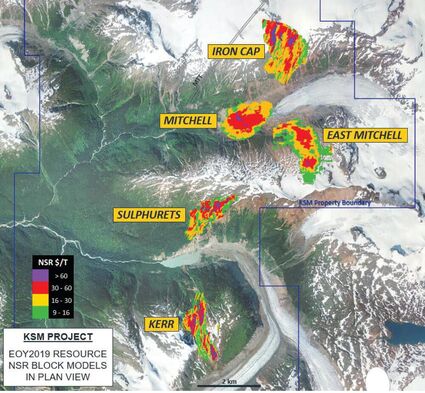A 72-year mining opportunity at KSM
PEA outlines 39 years of block cave mining following the 33-year mine plan detailed in a PFS for surface mining at KSM North of 60 Mining News – August 5, 2022
Last updated 8/11/2022 at 2:38pm

Kevin Burt; Courtesy of Seabridge Gold Inc.
Drilling has outlined 154 million oz of gold, 54.5 billion lb of copper, 820 million oz of silver, and 1.16 billion lb of molybdenum in five deposits at the KSM project in BC.
Following the 33 years of surface mining outlined in a recent prefeasibility study, the KSM project in British Columbia's Golden Triangle would still have enough resources to support an additional 39 years of underground mining, according to a new preliminary economic assessment prepared for Seabridge Gold Inc.
In early July, Seabridge published the results of a prefeasibility study for an open-pit mining operation at KSM that would produce an average of more than 1 million ounces of gold, 3 million oz of silver, 178 million pounds of copper and 4.2 million lb of molybdenum annually for 33 years.
This mine plan considers open pit mining 2.29 billion metric tons of proven and probable reserves averaging 0.64 grams per metric ton (47.3 million oz) gold, 0.14% (7.32 billion lb) copper, 2.2 g/t (160 million oz) silver, and 76 ppm (385 million lb) molybdenum contained within the Mitchell, East Mitchell and Sulphurets deposits.
This, however, only represents a small portion of the overall resources that have been outlined so far across the world-class KSM project.
According to the most recent calculation, KSM hosts 5.4 billion metric tons of measured and indicated resources averaging 0.51 g/t (88.3 million oz) gold, 0.16% (19.4 billion lb) copper, 2.4 g/t (414 million oz) silver, and 63 parts per million (742 million lb) molybdenum; plus 5.7 billion metric tons of inferred resource averaging 0.36 g/t (65.6 million oz) gold, 0.28% (35.1 billion lb) copper, 2.2 g/t (406 million oz) silver, and 33 ppm (415 million lb) molybdenum.
The new PEA offers a first glance of an underground block cave mine that would extend mining on this district-scale property to the end of the 21st century.
"KSM is really an entire district hosting a nest of potentially economic porphyry deposits with different characteristics," said Seabridge Gold Chairman and CEO Rudi Fronk. "In our updated PFS we focused on the gold-rich deposits because of their faster payback and the relative simplicity of an open-pit only operation. However, we are very mindful that a deep deficit in mined copper is projected to be on the horizon as the world electrifies and moves towards a net zero carbon future. We therefore wanted to highlight KSM's potential to contribute to addressing this need more fully than the mine plan contained in our updated Preliminary Feasibility Study."
Attractive future opportunity
The 2022 PEA envisions an underground-focused mine plan that would start with the development of a block cave mine at Iron Cap that would be supplemented with a small open pit at Kerr. This would be followed up by block cave mining at Kerr for the final 20 years of mining.
Over the 39 years of mining considered in the PEA, 14.3 million oz of gold, 14.3 billion lb of copper, 68.2 million oz of silver, and 13.8 million lb of molybdenum would be produced from 1.7 billion metric tons of mill feed mined from these deposits.
Over the entire 39-year mine life, mill feed will be delivered to a flotation concentration mill circuit. The flotation plant will produce a gold-copper-silver concentrate and separate molybdenum concentrate for transport by truck to a port in the nearby town of Stewart, BC.
This mine plan is based on 223 million metric tons of measured and indicated resources averaging 0.31 g/t (2.5 million oz) gold, 0.45% (2.23 billion lb) copper, and 1.8 g/t (43.6 million oz) silver; plus 1.47 billion metric tons of inferred resource averaging 0.44 g/t (20.7 million oz) gold, 0.43% (13.78 billion lb) copper, and 2.3 g/t (109 million oz) silver in the Iron Cap and Kerr deposit.
Initial capital cost for the mine detailed in the PEA is estimated at US$1.5 billion, with sustaining capital over the 39-year mine life estimated at US$12.8 billion, dominated by block cave development capital.

Seabridge Gold Inc.
11 billion metric tons of measured, indicated, and inferred resources have been outlined so far in five deposits at KSM.
When you apply the credits for the gold, silver, and molybdenum produced, the total average cost to produce a pound of copper over the life of the mine is estimated to be US$1.44.
Based on US$1,742/oz gold, US$3.53/lb copper, US$21.90/lb silver, and US$18/lb molybdenum, this operation would generate a post-tax net present value (5% discount) of US$5.8 billion and an internal rate of return of 18.9%.
Under this scenario, it would take roughly 6.2 years to pay back the capital for developing the underground mine at KSM.
With none of the resources in the earlier Mitchell-East Mitchell PFS included in the underground mining-focused PEA, this mine plan represents a completely separate opportunity for continuous mining at KSM for at least 72 years.
"We think this opportunity will be attractive to a prospective partner," said Fronk.
















Reader Comments(0)